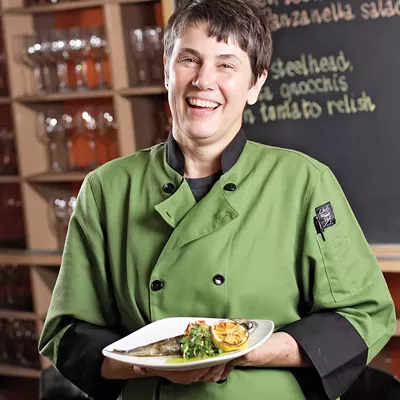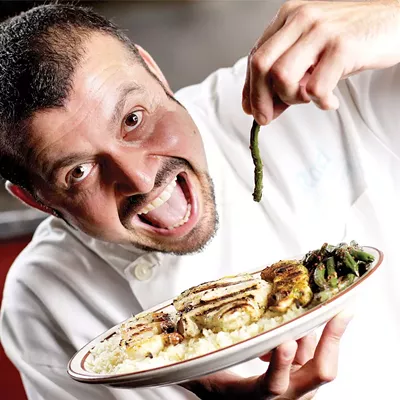Steaks and ground beef. When the average chef is looking to buy a hunk of cow from Gary Angell, proprietor of Rocky Ridge Farms, that’s almost always what they’re looking for. Retail customers, too. “I hardly ever sell a roast,” Angell says.
Jeremy Hansen — chef, owner, head butcher at Santé (404 W. Main Ave.) — though, he’ll take the whole damn thing. Snout to tail. Bones, viscera, everything. He’d take the guts too, and the organ meat, if the health department would let him. But they don’t — something about organ meat being dangerous, because of the way the vast majority of animals are farmed in this country. Hansen’s words: “so if the guts are unsafe, we’re supposed to believe what? The rest is fine?” He puts his hands out like, Is that supposed to add up?
But factory farming is a whole other issue, and it infuriates Hansen, so we won’t go there right now.
We’re talking about buying four whole, grass-fed, sustainably raised cows from Rocky Ridge this year — which Hansen did — along with 30 or 40 entire Berkshire hogs (what Angell characterizes as “about half” the farm’s total pork stock), dozens of ducks, a few turkeys, rabbits, salmon, halibut, game hens like quail … “I’m breaking down a lamb later today.”
And when Hansen says “breaking down,” that’s what he means. The flank and back and shoulder and butt come off the carcass like the fender, doors and wheels of a late-model Honda Civic in a chop shop. The animal is disassembled piece by piece until it disappears completely. All that remains are its component parts, which are broken down further — cut or sliced or ground into a medley of wonderful things. It’s precise, methodical work, but faster every time Hansen does it. “The first pig I broke down took eight hours … over eight hours,” he recalls. Now he’s down to an hour and a half.
Hansen turns parts of the ducks he gets into confit (curing them and then poaching them in their own fat), makes duck prosciutto with the rest of the meat, then renders the fat and cooks the bones for stock.
He does this with everything that comes through the door. Well, almost everything. “Salmon bones are useless,” he says. So there’s one thing he throws away.
The concept of whole-beast cooking caught fire in this last decade, reaching mainstream consciousness with the publication of London chef Fergus Henderson’s The Whole Beast. The ethic has become a mainstay at restaurants in culinary capitals like New York, L.A. and Portland, but hasn’t really caught on in Spokane.
Hansen’s trying to change that. In addition to the freedom afforded by creating your own sausage, pancetta and guanciale, the cost savings when buying a dead pig compared to a dead-and-cut-up pig is significant. Last time he checked, he says, a pork chop from an average food service — the kind used by most restaurants — was about $9 per pound. Hansen’s chops work out to about $2 per pound. If the chef/butcher were to add in his own labor costs, “you’d add, say, $2 to that.” Still less than half the price.
In all the many accolades Santé has received in the past two years, this is the story least told. More than the molecular gastronomy or the elaborate multi-course meals, though, the whole-beast ethic is what allows Hansen to achieve his vision while staying affordable and sticking to his principles.
Santé can buy better meat from hogs and beeves on a grain-free diet, staying away from the hormones of factory farms while balancing out the omega fatty acids in the meat and decreasing the cholesterol. It creates extra work — which, to Hansen, means “I feel it on payday” — but that has a benefit, too.
“I pay [the staff] a little better and give them more hours,” he says. His theory is that giving his team creative leeway to play around with a jowl here and a hock there means that along with earning a livable wage, they’ll also do better work.
Ultimately, though, Hansen says he hopes his staff moves on. “I want [chefs] to come and go — learn a ton and go start their own place,” he says, pausing, a smile working its way across his face. “Like disciples.” Spreading the gospel, one beast at a time.
Dining Out 2010
Get a chef to confide in you*, and one of two things will happen. If that chef is passionate about her work but works for someone else, she will undoubtedly talk about the frustrations and constraints of working around customers’ whims — or, maybe worse, an owner’s perception of a customer’s whims. She’ll talk about wanting to be free to make her art on her own terms — to open a restaurant that is only hers, and to make the food she loves making, regardless of who comes in the door.
Now get a chef who is also a restaurant owner to confide in you. She might complain about many things — payroll, a ruined panna cotta, an inexplicable kale shortage — but she won’t complain about feeling boxed in. At worst, she’ll feel misunderstood. But feeling misunderstood is a trait of all artists, isn’t it?
The chefs in Dining Out 2010 belong to that latter category. They have taken on tremendous personal and professional risk in the hope of reaping the tremendous reward of both freedom and success at the thing they love most. Their food and their stories inspire us. We hope they inspire you, too.
— Luke Baumgarten, Section Editor
* This may take a drink or two, and you may have to do some confiding yourself.

















